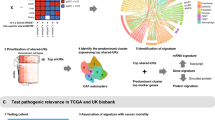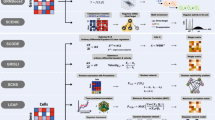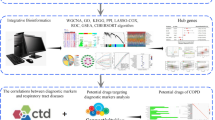Abstract
Endometriosis is a common gynecological disease associated with infertility, and it represents an economic burden worldwide. However, the molecular mechanisms underlying endometriosis development have not yet been fully elucidated. Here, we aimed to identify reliable key genes and the related regulatory network that may be involved in endometriosis. Differentially expressed genes (DEGs) were identified through integrated analysis of four expression datasets of endometriosis from Gene Expression Omnibus. Gene functional analysis and protein–protein interaction network construction were performed to reveal the potential function of DEGs. Subsequently, candidate hub genes were defined and validated in GSE105764 dataset, and the associated regulatory networks were constructed. Additionally, GSE120103 dataset was applied to identify the differential expression between the infertile and fertile groups of patients with stage IV endometriosis. Finally, real-time quantitative polymerase chain reaction analysis was performed to identify the differential expression of hub genes in the collected clinical specimens. Robust rank aggregation integrated analysis determined 158 DEGs. Epithelial cell differentiation was the most significantly enriched biological process, and leukocyte transendothelial migration was the most significantly enriched pathway. Eight hub genes including CLDN3, CLDN5, CLDN7, CLDN11, HOXC8, HOXC6, HOXB6, and HOXB7 were identified, and most of these were validated as abnormally expressed genes in both the infertile group and patients with endometriosis. Transcriptional factors and microRNAs related to these genes were identified. Altogether, our integrated analysis identified critical gene signatures, involved pathways, and regulatory networks, which could provide clinically significant insights into the molecular mechanisms underlying endometriosis and its related infertility.







Similar content being viewed by others
Data Availability
The datasets (GSE7305, GSE11691, GSE25628, GSE23339, GSE105764, and GSE120103) used for this study can be found in the Gene Expression Omnibus (GEO) database (http://www.ncbi.nlm.nih.gov/).
Code Availability
All code used during the study are available from the corresponding author by request.
Abbreviations
- GO:
-
Gene Ontology
- KEGG:
-
Kyoto Encyclopedia of Genes and Genomes
- DEG:
-
Differentially expressed gene
- PPI:
-
Protein–protein interaction
- TF:
-
Transcription factor
- MCODE:
-
Molecular complex detection
- RRA:
-
Robust rank aggregation
- RT-qPCR:
-
Real-time quantitative polymerase chain reaction
- SNP:
-
Single-nucleotide polymorphism
- GWAS:
-
Genome-wide association study
References
Zondervan KT, Becker CM, Koga K, Missmer SA, Taylor RN, Vigano P. Endometriosis Nat Rev Dis Primers. 2018;4(1):9. https://doi.org/10.1038/s41572-018-0008-5.
Zondervan KT, Becker CM, Missmer SA. Endometriosis. N Engl J Med. 2020;382(13):1244–56. https://doi.org/10.1056/NEJMra1810764.
Shafrir AL, Farland LV, Shah DK, Harris HR, Kvaskoff M, Zondervan K, et al. Risk for and consequences of endometriosis: a critical epidemiologic review. Best Pract Res Clin Obstet Gynaecol. 2018;51:1–15. https://doi.org/10.1016/j.bpobgyn.2018.06.001.
Van Gorp T, Amant F, Neven P, Vergote I, Moerman P. Endometriosis and the development of malignant tumours of the pelvis. A review of literature. Best Pract Res Clin Obstet Gynaecol. 2004;18(2):349–71. https://doi.org/10.1016/j.bpobgyn.2003.03.001.
Mehedintu C, Plotogea MN, Ionescu S, Antonovici M. Endometriosis still a challenge. J Med Life. 2014;7(3):349–57.
Sampson JA. Metastatic or embolic endometriosis, due to the menstrual dissemination of endometrial tissue into the venous circulation. Am J Pathol. 1927;3(2):93-110 43.
Jiang L, Yan Y, Liu Z, Wang Y. Inflammation and endometriosis. Front Biosci (Landmark Ed). 2016;21:941–8. https://doi.org/10.2741/4431.
Parazzini F, Esposito G, Tozzi L, Noli S, Bianchi S. Epidemiology of endometriosis and its comorbidities. Eur J Obstet Gynecol Reprod Biol. 2017;209:3–7. https://doi.org/10.1016/j.ejogrb.2016.04.021.
Figueira PG, Abrao MS, Krikun G, Taylor HS. Stem cells in endometrium and their role in the pathogenesis of endometriosis. Ann N Y Acad Sci. 2011;1221:10–7. https://doi.org/10.1111/j.1749-6632.2011.05969.x.
El Sabeh M, Afrin S, Singh B, Miyashita-Ishiwata M, Borahay M. Uterine stem cells and benign gynecological disorders: role in pathobiology and therapeutic implications. Stem Cell Rev Rep. 2020. https://doi.org/10.1007/s12015-020-10075-w.
Cardoso JV, Perini JA, Machado DE, Pinto R, Medeiros R. Systematic review of genome-wide association studies on susceptibility to endometriosis. Eur J Obstet Gynecol Reprod Biol. 2020;255:74–82. https://doi.org/10.1016/j.ejogrb.2020.10.017.
Hever A, Roth RB, Hevezi P, Marin ME, Acosta JA, Acosta H, et al. Human endometriosis is associated with plasma cells and overexpression of B lymphocyte stimulator. Proc Natl Acad Sci U S A. 2007;104(30):12451–6. https://doi.org/10.1073/pnas.0703451104.
Hull ML, Escareno CR, Godsland JM, Doig JR, Johnson CM, Phillips SC, et al. Endometrial-peritoneal interactions during endometriotic lesion establishment. Am J Pathol. 2008;173(3):700–15. https://doi.org/10.2353/ajpath.2008.071128.
Crispi S, Piccolo MT, D’Avino A, Donizetti A, Viceconte R, Spyrou M, et al. Transcriptional profiling of endometriosis tissues identifies genes related to organogenesis defects. J Cell Physiol. 2013;228(9):1927–34. https://doi.org/10.1002/jcp.24358.
Hawkins SM, Creighton CJ, Han DY, Zariff A, Anderson ML, Gunaratne PH, et al. Functional microRNA involved in endometriosis. Mol Endocrinol. 2011;25(5):821–32. https://doi.org/10.1210/me.2010-0371.
Zhao L, Gu C, Ye M, Zhang Z, Li L, Fan W, et al. Integration analysis of microRNA and mRNA paired expression profiling identifies deregulated microRNA-transcription factor-gene regulatory networks in ovarian endometriosis. Reprod Biol Endocrinol. 2018;16(1):4. https://doi.org/10.1186/s12958-017-0319-5.
Barrett T, Wilhite SE, Ledoux P, Evangelista C, Kim IF, Tomashevsky M, et al. NCBI GEO: archive for functional genomics data sets–update. Nucleic Acids Res. 2013;41(Database issue):991–5. https://doi.org/10.1093/nar/gks1193.
Colaprico A, Silva TC, Olsen C, Garofano L, Cava C, Garolini D, et al. TCGAbiolinks: an R/Bioconductor package for integrative analysis of TCGA data. Nucleic Acids Res. 2016;44(8):e71. https://doi.org/10.1093/nar/gkv1507.
Ritchie ME, Phipson B, Wu D, Hu Y, Law CW, Shi W, et al. limma powers differential expression analyses for RNA-sequencing and microarray studies. Nucleic Acids Res. 2015;43(7):e47. https://doi.org/10.1093/nar/gkv007.
Kolde R, Laur S, Adler P, Vilo J. Robust rank aggregation for gene list integration and meta-analysis. Bioinformatics. 2012;28(4):573–80. https://doi.org/10.1093/bioinformatics/btr709.
Korotkov A, Mills JD, Gorter JA, van Vliet EA, Aronica E. Systematic review and meta-analysis of differentially expressed miRNAs in experimental and human temporal lobe epilepsy. Sci Rep. 2017;7(1):11592. https://doi.org/10.1038/s41598-017-11510-8.
Zhou Y, Zhou B, Pache L, Chang M, Khodabakhshi AH, Tanaseichuk O, et al. Metascape provides a biologist-oriented resource for the analysis of systems-level datasets. Nat Commun. 2019;10(1):1523. https://doi.org/10.1038/s41467-019-09234-6.
Liao Y, Wang J, Jaehnig EJ, Shi Z, Zhang B. WebGestalt 2019: gene set analysis toolkit with revamped UIs and APIs. Nucleic Acids Res. 2019;47(W1):W199–205. https://doi.org/10.1093/nar/gkz401.
Szklarczyk D, Franceschini A, Wyder S, Forslund K, Heller D, Huerta-Cepas J, et al. STRING v10: protein-protein interaction networks, integrated over the tree of life. Nucleic Acids Res. 2015;43(Database issue):D447-52. https://doi.org/10.1093/nar/gku1003.
Shannon P, Markiel A, Ozier O, Baliga NS, Wang JT, Ramage D, et al. Cytoscape: a software environment for integrated models of biomolecular interaction networks. Genome Res. 2003;13(11):2498–504. https://doi.org/10.1101/gr.1239303.
Bandettini WP, Kellman P, Mancini C, Booker OJ, Vasu S, Leung SW, et al. MultiContrast Delayed Enhancement (MCODE) improves detection of subendocardial myocardial infarction by late gadolinium enhancement cardiovascular magnetic resonance: a clinical validation study. J Cardiovasc Magn Reson. 2012;14:83. https://doi.org/10.1186/1532-429X-14-83.
Chin CH, Chen SH, Wu HH, Ho CW, Ko MT, Lin CY. cytoHubba: identifying hub objects and sub-networks from complex interactome. BMC Syst Biol. 2014;8(Suppl 4):S11. https://doi.org/10.1186/1752-0509-8-S4-S11.
Zhou G, Soufan O, Ewald J, Hancock REW, Basu N, Xia J. NetworkAnalyst 3.0: a visual analytics platform for comprehensive gene expression profiling and meta-analysis. Nucleic Acids Res. 2019;47(W1):W234–41. https://doi.org/10.1093/nar/gkz240.
Lachmann A, Xu H, Krishnan J, Berger SI, Mazloom AR, Ma’ayan A. ChEA: transcription factor regulation inferred from integrating genome-wide ChIP-X experiments. Bioinformatics. 2010;26(19):2438–44. https://doi.org/10.1093/bioinformatics/btq466.
Soifer HS, Rossi JJ, Saetrom P. MicroRNAs in disease and potential therapeutic applications. Mol Ther. 2007;15(12):2070–9. https://doi.org/10.1038/sj.mt.6300311.
Sticht C, De La Torre C, Parveen A, Gretz N. miRWalk: An online resource for prediction of microRNA binding sites. PLoS ONE. 2018;13(10):e0206239. https://doi.org/10.1371/journal.pone.0206239.
Sekhon RS, Briskine R, Hirsch CN, Myers CL, Springer NM, Buell CR, et al. Maize gene atlas developed by RNA sequencing and comparative evaluation of transcriptomes based on RNA sequencing and microarrays. PLoS ONE. 2013;8(4):e61005. https://doi.org/10.1371/journal.pone.0061005.
Zhang W, Yu Y, Hertwig F, Thierry-Mieg J, Zhang W, Thierry-Mieg D, et al. Comparison of RNA-seq and microarray-based models for clinical endpoint prediction. Genome Biol. 2015;16:133. https://doi.org/10.1186/s13059-015-0694-1.
Love MI, Huber W, Anders S. Moderated estimation of fold change and dispersion for RNA-seq data with DESeq2. Genome Biol. 2014;15(12):550. https://doi.org/10.1186/s13059-014-0550-8.
Chin C-H, Chen S-H, Wu H-H, Ho C-W, Ko M-T, Lin C-Y. cytoHubba: identifying hub objects and sub-networks from complex interactome. BMC Systems Biology. 2014;8(Suppl 4). https://doi.org/10.1186/1752-0509-8-s4-s11
Chapron C, Marcellin L, Borghese B, Santulli P. Rethinking mechanisms, diagnosis and management of endometriosis. Nat Rev Endocrinol. 2019;15(11):666–82. https://doi.org/10.1038/s41574-019-0245-z.
Dai Y, Li X, Shi J, Leng J. A review of the risk factors, genetics and treatment of endometriosis in Chinese women: a comparative update. Reprod Health. 2018;15(1):82. https://doi.org/10.1186/s12978-018-0506-7.
Vercellini P, Vigano P, Somigliana E, Fedele L. Endometriosis: pathogenesis and treatment. Nat Rev Endocrinol. 2014;10(5):261–75. https://doi.org/10.1038/nrendo.2013.255.
Czyzyk A, Podfigurna A, Szeliga A, Meczekalski B. Update on endometriosis pathogenesis. Minerva Ginecol. 2017;69(5):447–61. https://doi.org/10.23736/S0026-4784.17.04048-5.
Jiang L, Zhang M, Wang S, Han Y, Fang X. Common and specific gene signatures among three different endometriosis subtypes. PeerJ. 2020;8:e8730. https://doi.org/10.7717/peerj.8730.
Dai FF, Bao AY, Luo B, Zeng ZH, Pu XL, Wang YQ, et al. Identification of differentially expressed genes and signaling pathways involved in endometriosis by integrated bioinformatics analysis. Exp Ther Med. 2020;19(1):264–72. https://doi.org/10.3892/etm.2019.8214.
Chen M, Zhou Y, Xu H, Hill C, Ewing RM, He D, et al. Bioinformatic analysis reveals the importance of epithelial-mesenchymal transition in the development of endometriosis. Sci Rep. 2020;10(1):8442. https://doi.org/10.1038/s41598-020-65606-9.
Yang H, Kang K, Cheng C, Mamillapalli R, Taylor HS. Integrative analysis reveals regulatory programs in endometriosis. Reprod Sci. 2015;22(9):1060–72. https://doi.org/10.1177/1933719115592709.
Timmerman I, Daniel AE, Kroon J, van Buul JD. Leukocytes crossing the endothelium: a matter of communication. Int Rev Cell Mol Biol. 2016;322:281–329. https://doi.org/10.1016/bs.ircmb.2015.10.005.
Niu Z, Chen YH, Zhang K. Polymorphonuclear leukocyte transendothelial migration proceeds at blood-brain barrier in neonatal meningitis. Front Microbiol. 2020;11:969. https://doi.org/10.3389/fmicb.2020.00969.
Ramachandran P, Dobie R, Wilson-Kanamori JR, Dora EF, Henderson BEP, Luu NT, et al. Resolving the fibrotic niche of human liver cirrhosis at single-cell level. Nature. 2019;575(7783):512–8. https://doi.org/10.1038/s41586-019-1631-3.
Klarin D, Zhu QM, Emdin CA, Chaffin M, Horner S, McMillan BJ, et al. Genetic analysis in UK Biobank links insulin resistance and transendothelial migration pathways to coronary artery disease. Nat Genet. 2017;49(9):1392–7. https://doi.org/10.1038/ng.3914.
Reichert S, Scheid S, Roth T, Herkel M, Petrova D, Linden A, et al. Semaphorin 3F promotes transendothelial migration of leukocytes in the inflammatory response after survived cardiac arrest. Inflammation. 2019;42(4):1252–64. https://doi.org/10.1007/s10753-019-00985-4.
Gerhardt T, Ley K. Monocyte trafficking across the vessel wall. Cardiovasc Res. 2015;107(3):321–30. https://doi.org/10.1093/cvr/cvv147.
Parkin KL, Fazleabas AT. Uterine leukocyte function and dysfunction: a hypothesis on the impact of endometriosis. Am J Reprod Immunol. 2016;75(3):411–7. https://doi.org/10.1111/aji.12487.
Izumi G, Koga K, Takamura M, Makabe T, Satake E, Takeuchi A, et al. Involvement of immune cells in the pathogenesis of endometriosis. J Obstet Gynaecol Res. 2018;44(2):191–8. https://doi.org/10.1111/jog.13559.
Symons LK, Miller JE, Tyryshkin K, Monsanto SP, Marks RM, Lingegowda H, et al. Neutrophil recruitment and function in endometriosis patients and a syngeneic murine model. FASEB J. 2020;34(1):1558–75. https://doi.org/10.1096/fj.201902272R.
de Barros IBL, Malvezzi H, Gueuvoghlanian-Silva BY, Piccinato CA, Rizzo LV, Podgaec S. What do we know about regulatory T cells and endometriosis? A systematic review. J Reprod Immunol. 2017;120:48–55. https://doi.org/10.1016/j.jri.2017.04.003.
Tran LV, Tokushige N, Berbic M, Markham R, Fraser IS. Macrophages and nerve fibres in peritoneal endometriosis. Hum Reprod. 2009;24(4):835–41. https://doi.org/10.1093/humrep/den483.
Drury JA, Parkin KL, Coyne L, Giuliani E, Fazleabas AT, Hapangama DK. The dynamic changes in the number of uterine natural killer cells are specific to the eutopic but not to the ectopic endometrium in women and in a baboon model of endometriosis. Reprod Biol Endocrinol. 2018;16(1):67. https://doi.org/10.1186/s12958-018-0385-3.
Riccio L, Santulli P, Marcellin L, Abrao MS, Batteux F, Chapron C. Immunology of endometriosis. Best Pract Res Clin Obstet Gynaecol. 2018;50:39–49. https://doi.org/10.1016/j.bpobgyn.2018.01.010.
Vallve-Juanico J, Houshdaran S, Giudice LC. The endometrial immune environment of women with endometriosis. Hum Reprod Update. 2019;25(5):564–91. https://doi.org/10.1093/humupd/dmz018.
Jeljeli M, Riccio LGC, Chouzenoux S, Moresi F, Toullec L, Doridot L, et al. Macrophage Immune Memory Controls Endometriosis in Mice and Humans. Cell Rep. 2020;33(5):108325. https://doi.org/10.1016/j.celrep.2020.108325.
Le NXH, Loret de Mola JR, Bremer P, Groesch K, Wilson T, Diaz-Sylvester P et al. Alteration of systemic and uterine endometrial immune populations in patients with endometriosis. Am J Reprod Immunol. 2020;e13362. https://doi.org/10.1111/aji.13362.
Konrad L, Dietze R, Riaz MA, Scheiner-Bobis G, Behnke J, Horné F et al. Epithelial–mesenchymal transition in endometriosis—when does it happen? Journal of Clinical Medicine. 2020;9(6). https://doi.org/10.3390/jcm9061915.
Gaetje R, Holtrich U, Engels K, Kissler S, Rody A, Karn T, et al. Differential expression of claudins in human endometrium and endometriosis. Gynecol Endocrinol. 2008;24(8):442–9. https://doi.org/10.1080/09513590802242694.
Pan X-Y, Li X, Weng Z-P, Wang B. Altered expression of claudin-3 and claudin-4 in ectopic endometrium of women with endometriosis. Fertil Steril. 2009;91(5):1692–9. https://doi.org/10.1016/j.fertnstert.2007.11.095.
Hoerscher A, Horne F, Dietze R, Berkes E, Oehmke F, Tinneberg HR, et al. Localization of claudin-2 and claudin-3 in eutopic and ectopic endometrium is highly similar. Arch Gynecol Obstet. 2020;301(4):1003–11. https://doi.org/10.1007/s00404-020-05472-y.
Horné F, Dietze R, Berkes E, Oehmke F, Tinneberg H-R, Meinhold-Heerlein I, et al. Impaired localization of claudin-11 in endometriotic epithelial cells compared to endometrial cells. Reprod Sci. 2018;26(9):1181–92. https://doi.org/10.1177/1933719118811643.
Du H, Taylor HS. The role of hox genes in female reproductive tract development, adult function, and fertility. Cold Spring Harb Perspect Med. 2015;6(1):a023002. https://doi.org/10.1101/cshperspect.a023002.
Zanatta A, Rocha AM, Carvalho FM, Pereira RM, Taylor HS, Motta EL, et al. The role of the Hoxa10/HOXA10 gene in the etiology of endometriosis and its related infertility: a review. J Assist Reprod Genet. 2010;27(12):701–10. https://doi.org/10.1007/s10815-010-9471-y.
Esfandiari F, Favaedi R, Heidari-Khoei H, Chitsazian F, Yari S, Piryaei A, et al. Insight into epigenetics of human endometriosis organoids: DNA methylation analysis of HOX genes and their cofactors. Fertil Steril. 2021;115(1):125–37. https://doi.org/10.1016/j.fertnstert.2020.08.1398.
Huang Y, Chen L, Guo A. Upregulated expression of HOXC8 is associated with poor prognosis of cervical cancer. Oncol Lett. 2018;15(5):7291–6. https://doi.org/10.3892/ol.2018.8200.
Lu S, Liu R, Su M, Wei Y, Yang S, He S, et al. Overexpression of HOXC8 is associated with poor prognosis in epithelial ovarian cancer. Reprod Sci. 2016;23(7):944–54. https://doi.org/10.1177/1933719115625845.
Mihara Y, Maekawa R, Sato S, Shimizu N, Doi-Tanaka Y, Takagi H et al. An integrated genomic approach identifies hoxc8 as an upstream regulator in ovarian endometrioma. J Clin Endocrinol Metab. 2020;105(12). https://doi.org/10.1210/clinem/dgaa618.
Mirza Z, Abdel-dayem UA. Uncovering potential roles of differentially expressed genes, upstream regulators, and canonical pathways in endometriosis using an in silico genomics approach. Diagnostics. 2020;10(6). https://doi.org/10.3390/diagnostics10060416.
Birt JA, Nabli H, Stilley JA, Windham EA, Frazier SR, Sharpe-Timms KL. Elevated peritoneal fluid TNF-alpha incites ovarian early growth response factor 1 expression and downstream protease mediators: a correlation with ovulatory dysfunction in endometriosis. Reprod Sci. 2013;20(5):514–23. https://doi.org/10.1177/1933719113477479.
Chiang S, Ali R, Melnyk N, McAlpine JN, Huntsman DG, Gilks CB, et al. Frequency of known gene rearrangements in endometrial stromal tumors. Am J Surg Pathol. 2011;35(9):1364–72. https://doi.org/10.1097/PAS.0b013e3182262743.
Tokinaga A, Furuya M, Niino H, Udaka N, Asai-Sato M, Sekido H, et al. Colonic low-grade endometrial stromal sarcoma and orthotopic endometrial stromal tumor with limited infiltration sharing the JAZF1-SUZ12 gene fusion. Pathol Int. 2014;64(4):178–82. https://doi.org/10.1111/pin.12151.
Ponandai-Srinivasan S, Saare M, Boggavarapu NR, Frisendahl C, Ehrstrom S, Riethmuller C, et al. Syndecan-1 modulates the invasive potential of endometrioma via TGF-beta signalling in a subgroup of women with endometriosis. Hum Reprod. 2020;35(10):2280–93. https://doi.org/10.1093/humrep/deaa164.
Forte A, Schettino MT, Finicelli M, Cipollaro M, Colacurci N, Cobellis L, et al. Expression pattern of stemness-related genes in human endometrial and endometriotic tissues. Mol Med. 2009;15(11–12):392–401. https://doi.org/10.2119/molmed.2009.00068.
Acknowledgements
The authors would like to acknowledge the GEO database for the gene expression profiles of endometriosis.
Funding
This work was supported by the National Natural Science Foundation of China (No.81302275, 81672560), the GuSu Medical Youth Talent (No. GSWS2019034), and the Project of Jiangsu Provincial Maternal and Child Health Association (No. FYX201709).
Author information
Authors and Affiliations
Contributions
All the listed authors have made essential contributions to the work. Qiutong Li and Min Xi analyzed the data and drafted the original manuscript. Fangrong Shen and Fengqing Fu interpreted and validated the results. Juan Wang conceived the study and participated in its design and coordination. Jinhua Zhou and Youguo Chen supervised the project design and reviewed the manuscript. All authors have read and approved the final manuscript for publication.
Corresponding authors
Ethics declarations
Ethics Approval
The study was performed in accordance with the ethical standards as laid down in the 1964 Declaration of Helsinki and its later amendments or comparable ethical standards. Informed consent was obtained from all the patients and the retrospective study involving human participants was approved by The Ethics Committee of The First Affiliated Hospital of Soochow University (Soochow, China). All the data from the public databases were not involved.
Consent to Participate
Not applicable.
Consent for Publication
All the co-authors have agreed to publication in the journal.
Conflict of Interest
The authors declare no competing interests.
Additional information
Publisher's Note
Springer Nature remains neutral with regard to jurisdictional claims in published maps and institutional affiliations.
Qiutong Li and Min Xi contributed equally to this work.
Supplementary Information
Below is the link to the electronic supplementary material.
Rights and permissions
About this article
Cite this article
Li, Q., Xi, M., Shen, F. et al. Identification of Candidate Gene Signatures and Regulatory Networks in Endometriosis and its Related Infertility by Integrated Analysis. Reprod. Sci. 29, 411–426 (2022). https://doi.org/10.1007/s43032-021-00766-1
Received:
Accepted:
Published:
Issue Date:
DOI: https://doi.org/10.1007/s43032-021-00766-1




